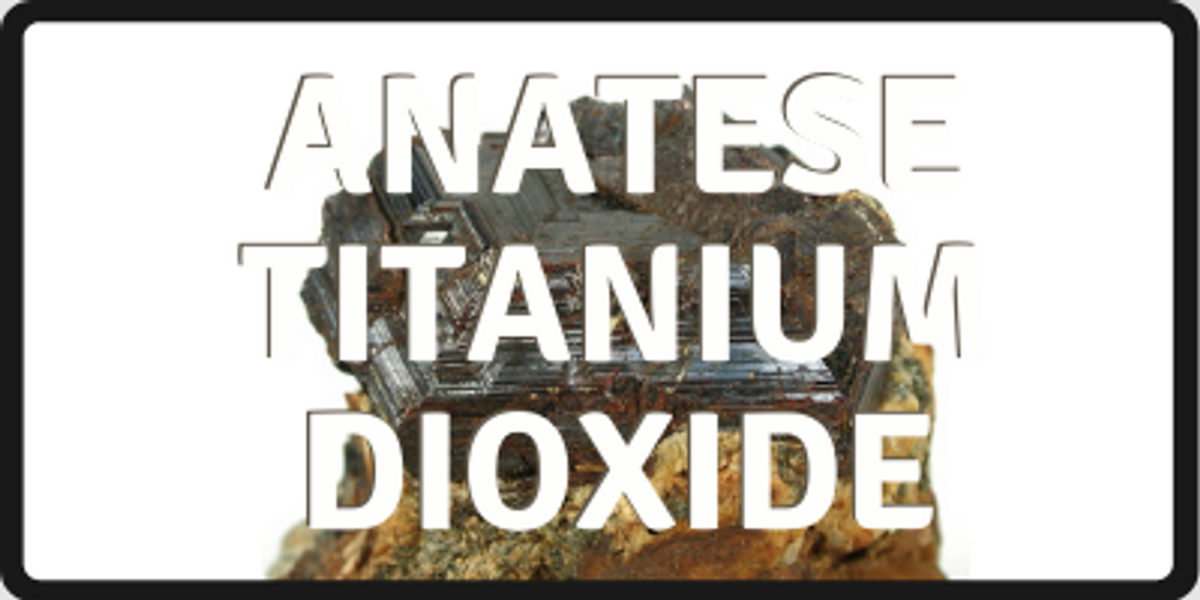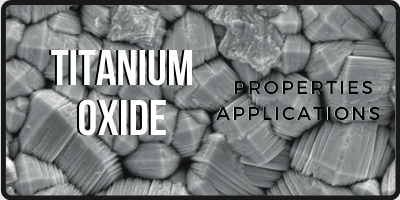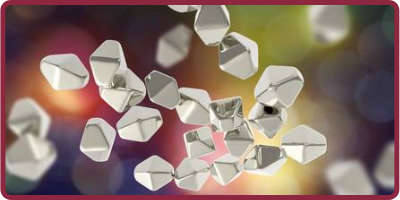Analyzed: Anatase Titanium Dioxide Nanoparticles
Ultrafine anatase titanium dioxide nanoparticles and nanocrystals (TiO2) with average particle size of less than 100nm have ultra-violate (UV) radiation blocking properties as well as the ability to prevent photocatalytic reaction if they are coated with alumina and silica.
Also, the titanium dioxide nanoparticles have applications in materials for construction purposes such as antifogging coatings and windows with self-cleaning quality. Titanium dioxide nanoparticle are referred as a safe sun blocking agent in sunscreens and UV protections creams with the least health risks compared to others. Nanoscale titanium oxide forms during a state of metastability of anatase which is the mineral of titanium dioxide since the surface energy in the anatase phase is lower than that of the equilibrium phase.
Titanium Dioxide (TiO2)
Titanium oxide, which is also called titania, is a naturally occurring +4 oxidation state of titanium used as a pigment known as titanium as well as in food coloring, sunscreen and paints. There are three main crystalline structures of titanium oxide namely anatase, ilmenite and rutile. It has more high-pressure titanium oxide minerals called akaogiite which is a monolithic crystal and the other one as brookite that is an orthorhombic crystalline structure. Among all, ilmenite is the most abundant on Earth crust. It constitutes nearly two-third of the available and known pigments and is regarded to play a key role in world energy generation purposes with environmental promises. Titanium dioxide is an n-type semiconductor with a broad band gap and has charge transport, surface and light absorption qualities. The cost-effective, inert and stable titanium dioxide is known for its remarkable photostable and photoactive properties making it the focus of numerous research projects in recent years 1.
Learn More About Titanium Oxide By Clicking to Image Below
Anatase Titanium Dioxide Nanoparticles
Anatase titanium dioxide nanoparticles are considered the most commonly synthesized and industrially more important manufactured nanoparticle since the appearance of nanoscience and nanotechnology. This is mainly because of the fact that titanium dioxide nanoparticles are highly potential to contribute new functionalities to materials and compounds causing properties like self-cleanliness pollution removal quality through photocatalytic behavior activated by UV light 2. Generally, the anatase and rutile forms of titanium oxide are of industrial and importance. However, the anatase is more toxic and is extensively used for many purposes. Despite the toxic nature, titanium oxide nanoparticles are employed in research projects in vivo and in vitro probably due to a lack of enough reliable data of their toxicological effects and hazardous interactions with biomolecules 3.
Synthesis of Anatase Titanium Dioxide Nanoparticles
With regard to versatility of chemical methods of synthesizing nanoparticles, a lot of methods have also been suggested for the synthesis of anatase titanium dioxide nanoparticles and nanostructures. Microemulsion, hydrothermal crystallization, chemical vapor deposition, sol gel and chemical precipitation are the most common methods so far among which, sol get has turned out to be one of the most efficient and successful methods to obtain anatase titanium dioxide nanoparticles. Based on this procedure, highly photocatalytic titanium dioxide nanostructures with excellent control over the morphology and porosity are synthesized. In addition, the nanoparticles synthesized this way are perfectly homogenous with the high rate of purity and are achieved at lower temperatures.
In the recent years, template assisted methods have been included in the synthesis of titanium dioxide nanoparticles and nanostructures. Accordingly, the templating method is applied more frequently at the moment in order to modify the surface of nanoscale structures and improve their properties. The modification is necessarily done to avoid any possible post nucleation and agglomeration, create active sites on them and increase the selectivity, stability and compatibility. Specifically, to synthesize TiO2 nanoparticles, titanium isoproxide is dissolved in acetic acid and deionized water. The acetic acid serves as a chelating component to prevent water from nucleophilic attack on titanium isoproxide. The solution is stirred for a couple of hours with a subsequent addition of rice straw to the solution. At the next stage, the solution is heated at 80˚C to turn to the gel and is dried at the same temperature for over ten hours. The final stage involves grinding the resulting crystals and calcinating them at 500˚C 1.
In green synthesis method, titanium oxysulfate solution extraction from a plant is employed along with a carbohydrate polymer to form a solution with respective vigorous stirring, centrifuging and drying to obtain fine crystals with the final calcination at 500˚C for 4 hours 4.
Anatase Titanium Dioxide Nanoparticles Applications
So far, titanium dioxide nanoparticles and nanostructures have been applied broadly as semiconductors, catalysts, photocatalysts, in photovoltaic and water splitting devices and dye-synthesized solar cells. TiO2 nanoparticles are known to be biocompatible and environment friendly agents and can be used as optical biosensors too. Practically, TiO2 nanoparticles act as semiconductors and photocatalysts when they are irradiated by ultraviolet light when a gas or liquid is present. Titanium dioxide nanoparticles are able to decompose organic pollutants and aerosols through a photocatalytic reaction when they are mixed with cement. They have also been employed as very capable agents to remove aromatic, ammonia, NOx and aldehyde pollutants. TiO2 nanoparticles are increasingly being used for infrastructural projects as tunnels, buildings, pavements and where the use of concrete and cement are involved in construction industry. Differently, titanium dioxide nanoparticles have found applications in biological systems too. They are used in skin cancer treatment through activation by UV light with a high efficiency. As complex nanoparticles, TiO2 has been employed with doxorubicin (a cancer drug) in order to improve the its quality 5.
Click Image to Read Application of Titanium Dioxide Nanoparticles in Cancer Treatment
Safety Information about TiO2 Nanoparticles
It has been for so long that TiO2 is referred as the “environmental white knight” mostly because of the fact that it is inert in nature; its toxicity is restricted and that it biocompatible unless its concentration exceeds the healthy dose. TiO2 has been classified as a food additive since 1996 by the Food and Drug Administration (FDA) of the United States of America. According to FDA, 50µg per kilogram of human body weight a day is the healthy dose of titanium oxide nanoparticles. In addition to this, the Joint Expert Committee on Food Additives of the Food and Agriculture Organization/World Health Organization (JECFA), the European Food Safety Authority (EFSA)’s Scientific Panel on Food Additives, Flavorings, Processing Aids and Materials in Contact with Food have and the European Commission’s Scientific Committee on Food (SCF) have jointly and officially confirmed that the healthy dose intake in a day is safe 3.
Anatase titanium dioxide nanoparticles are the mostly studied and synthesized nanostructures with wide applications in biological systems for cancer treatment in science in photocatalytic reactions, sun blocking creams (sunscreens) and in industry due to their versatility to functionalized to adopt selectivity, purity and homogeneity. Titanium dioxide nanoparticles can also be obtained based on the green chemistry promises with environmentally friendly properties.
Click Image to Read About Difference Between Anatase and Rutile Titanium Dioxide (TiO2) Nanoparticles
References
1. Ramimoghadam, D., Bagheri, S. & Abd Hamid, S. B. Biotemplated synthesis of anatase titanium dioxide nanoparticles via lignocellulosic waste material. Biomed Res. Int. 2014, (2014).
2. Constantinides, G. Nanoscience and nanoengineering of cement-based materials. Nanotechnol. Eco-Efficient Constr. 9-37a (2013). doi:10.1533/9780857098832.1.7
3. Shah, S. N. A., Shah, Z., Hussain, M. & Khan, M. Hazardous Effects of Titanium Dioxide Nanoparticles in Ecosystem. Bioinorg. Chem. Appl. 2017, (2017).
4. Saranya, S. K. S. K. S. et al. Green synthesis of high temperature stable anatase titanium dioxide nanoparticles using gum kondagogu: Characterization and solar driven photocatalytic degradation of organic dye. Nanomaterials 8, (2018).
5. Salahuddin, N. & Galal, A. Improving chemotherapy drug delivery by nanoprecision tools. Nanostructures for Cancer Therapy (Elsevier Inc., 2017). doi:10.1016/B978-0-323-46144-3.00004-0
Recent Posts
-
Nanocomposites in Food Packaging
The utilization of nanocomposites in food packaging represents a significant advancement in the fiel …19th Apr 2024 -
What is the Difference Between 7075 and 6061 Aluminum Alloy?
When comparing 7075 aluminum alloy to 6061 aluminum alloy, it's essential to understand their disti …5th Apr 2024 -
Iron-Air Batteries: The Ultimate Guide
Iron-air batteries represent a significant breakthrough in energy storage technology, offering a sus …29th Mar 2024








